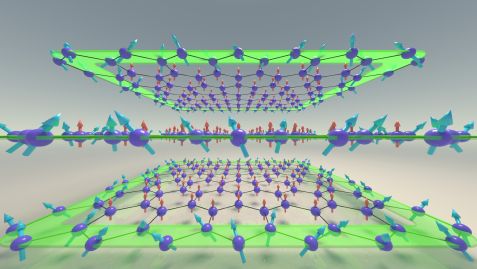MLZ is a cooperation between:
 > Technische Universität München
> Technische Universität München > Helmholtz-Zentrum Hereon
> Helmholtz-Zentrum Hereon
 > Forschungszentrum Jülich
> Forschungszentrum Jülich
MLZ is a member of:
 > LENS
> LENS > ERF-AISBL
> ERF-AISBL
MLZ on social media:

MLZ (eng)
Lichtenbergstr.1
85748 Garching
22.09.2021
Breakthrough in magnonics? Discovery of a new property in quantum materials
Lower energy consumption and new functions in semiconductor technology promises the new two-dimensional material. Researchers at Forschungszentrum Jülich have discovered new properties in quantum mechanics, together with team members from Germany, France and China. They achieved this with the future technology of magnonics.
Electronic devices as thin as a sheet of paper, flexible, transparent, with low energy consumption but fast computing power and enormous storage capacity – what was once science fiction is now moving within our grasp. With so-called “two-dimensional van der Waals materials”, it is now possible to implement many of the electronic properties that we use in today’s electronic devices, where typically semiconductors, electrical insulators, semimetals, metals and magnets are used. These crystalline materials are only one or two atomic layers thick, making them virtually two-dimensional.
This flat shape often creates properties that the same materials do not exhibit as solid crystals, because quantum mechanical phenomena at the interfaces cause the electrons to behave in a different way. The name “van der Waals” reflects the fact that although the atoms within a 2D layer are firmly connected to each other, the chemical bond to the substrate only occurs via weak, so-called “van der Waals forces”. This differentiates two-dimensional van der Waals materials from other thin-film systems.

Representation of magnonic waves at the edges of a 2D van der Waals material (highlighted in green). The arrows symbolize the magnetic moments, which are arranged in three layers of honeycomb lattice. © Forschungszentrum Jülich
Exotic properties with magnonic
Depending on the material composition and the lattice symmetry of the 2D systems, other properties can also emerge, such as optical or magnetic, as well as exotic properties not yet used in today’s electronics. The family of materials studied by the Jülich researchers exhibits ferromagnetic properties, in the manner of a classic bar magnet. Ferromagnetic properties are used today to store data, for example.
However, the scientists have now demonstrated a completely new property: the materials studied are topological insulators for magnons. Topological insulators for electric currents are already known as solids. These are actually electrical insulators, but conduct electricity with almost no resistance along their edges. Magnons are collective excitations in magnetic systems whose energy transfer is quantised. They can be thought of as waves that pass though the material, just as a stone thrown into water generates ripples. The magnetic moments in the material remain in place, only their orientation changes. In topological insulators for magnons, the latter propagate along the edges of the sample, in much the same way as topological insulators of electrons do.
Ten times less energy consumption
“As no electrical charge has to be transported when transmitting information using magnons, we expect energy consumption to be around ten times lower compared to using modern semiconductor chips. This is why magnonic devices are especially suitable for integration in mobile IT applications,” explains Prof. Yuriy Mokrousov from the Peter Grünberg Institute. He and his team were significantly involved in the interpretation of the observed data.
His collaboration partner Dr. Yixi Su from the Jülich Centre for Neutron Science explained that, using similar materials, it could be possible in future to create all the functions needed for magnonics technology on an integrated chip, or in other words, to develop the magnonics equivalent to semimetals or insulators. This is all thanks to the scientists’ results pointing the way to the targeted fine-tuning of the properties of this class of materials.
Together they painstakingly established the correlations between material composition, magnetic structure and magnonic properties. For one sample alone, they had to produce over a hundred high-purity crystals with a total weight of just 1.4 g and then assemble them so that their crystal planes matched. For their studies of magnonic properties using neutron scattering, they not only used their own instruments at the Institut Laue-Langevin in France, but also a further instrument at the same location as well as equipment at the Heinz Maier-Leibnitz Zentrum in Garching and the Helmholtz-Zentrum Berlin.
Original text: Angela Wenzik / JCNS
Original publication:
F. Zhu, L. Zhang, X. Wang et al.;Topological magnon insulators in two-dimensional van der Waals ferromagnets
CrSiTe3 and CrGeTe3: Toward intrinsic gap-tunability; Sci. Adv. 7, eabi7532 (2021)
DOI: 10.1126/sciadv.abi7532
Further Information:
Website of the Jülich Centre for Neutron Science
Website of the Peter Grünberg Instituts
Information about the instrument PUMA
Contakt:
Prof. Yuriy Mokrousov
Forschungszentrum Jülich
Peter Grünberg Institut – Quanten-Theorie der Materialien (PGI-1)
Tel. 02461 61-4434
E-Mail: y.mokrousov@fz-juelich.de
Dr. Yixi Su
Forschungszentrum Jülich
Jülich Centre for Neutron Science (JCNS-MLZ)
Tel. 0 89/158860-714
E-Mail: y.su@fz-juelich.de
Press contact:
Angela Wenzik
Science Journalist
Forschungszentrum Jülich
Tel. 02461 61-6048
E-Mail: a.wenzik@fz-juelich.de
MLZ is a cooperation between:
 > Technische Universität München
> Technische Universität München > Helmholtz-Zentrum Hereon
> Helmholtz-Zentrum Hereon
 > Forschungszentrum Jülich
> Forschungszentrum Jülich
MLZ is a member of:
 > LENS
> LENS > ERF-AISBL
> ERF-AISBL
MLZ on social media:



